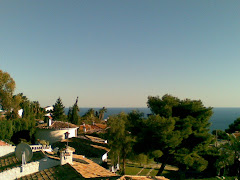
Eyes full of suffering fix on mine, guilt gags at the back of my throat, confusion quivers under my skin. Am I some how to blame? But for what? The beat of the drum changes, the trumpet’s wail intensifies, the paso continues its 45º turn and Christ’s eyes lock into someone else’s bewildered soul.
The Nazarenos follow in their white coned hats and black robes, their paschal candles illuminate the night. After all these years in Spain their covered faces are still sinister and anonymous to me like the Ku Klux Klan. The antique silver staff is tapped
three times on the pavement, the music ceases and the procession comes to a temporary rest. Spectators return to conversations, many weave in and out of the scene to get to a better spot, children try to cajole candle drippings from the silent Nazarenos to grow their wax ball like a snowball. Mistrust of these hidden penitents doesn’t exist for them.
I shift from leg to leg, rub my sore back, crane my neck to see if the Virgin is in sight yet. I think about Christ’s imploring eyes and wonder why I’m here. The trumpet thankfully interrupts, the drum beats again, brum brum, brum bum bum. A distant bell rings and the Nazarenos angle their candles towards each other forming a medieval-like arch over the street, they resume their silent shuffle. A slight hint of incense tickles my nose, the steady clanking of the swaying palio, (the canopy suspended over the statue) becomes clearer, flickering flames and the mourning Virgin finally appear in the distance above the white peaks. The second band, accompanying the Virgin, now marks the beat that the procession follows, sometimes slow and sorrowful, other times swift and exultant, but always steady and familiar. The costaleros (the men who carry the throne throughout the streets) sway the paso, gently rock it, inch it along or march it forward according to the music. The more frequently and elaborately they do this, the more the crowd applauds them. It is in hopes of seeing this spectacle that I wait so long for the Virgin to pass this corner I have staked as mine.
She is dressed in burgundy velvet, her black cloak, also velvet, is intricately embroidered in gold all the way to the end of it’s 4 meter train. The palio above her is embroidered to match. Her gilded halo shimmers in the night glow of candles and street lamps. The beautifully sculpted silver base overflows with white flowers: lilies, roses, carnations, freesias, gladiolas. She rests in front of us, I can hear the costaleros sigh in relief. A spontaneous saetero pays her homage, singing the traditional flamenco type song of pain and lament. At its end another admirer cheers Viva la Virgen, the crowd responds with Viva! They repeat this three times and the crowd breaks out in wild applause. The music begins again, the costaleros take their position and repay this homage with their beautiful display of maneuvers. As they progress down the street to the beat of the drum, the crowd’s applause lingers.
We have seen the entire procession, over sixty minutes standing still in the middle of a crowd, my body aches and I need air. I once again wonder why I do this, and why it means so much to me. My husband prods me on to the plaza to sit and have a drink. We watch the locals greet each other with kisses, and warm salutations and can’t help but notice the once-overs the women give each other in their show of new Spring fashions.
I ponder the contrast of the solemnity of Christ’s suffering paraded around town with this display of economic well-being, the full bars and restaurants, the festive atmosphere parading on the street corners.
Semana Santa in Andalucia, it simply magnifies what I have already concluded about the Catholic Church in Spain; it has become an institution of cultural rituals instead of spiritual support and moral guidance. What I find harder to conclude is what it has become for me.














.jpg)
